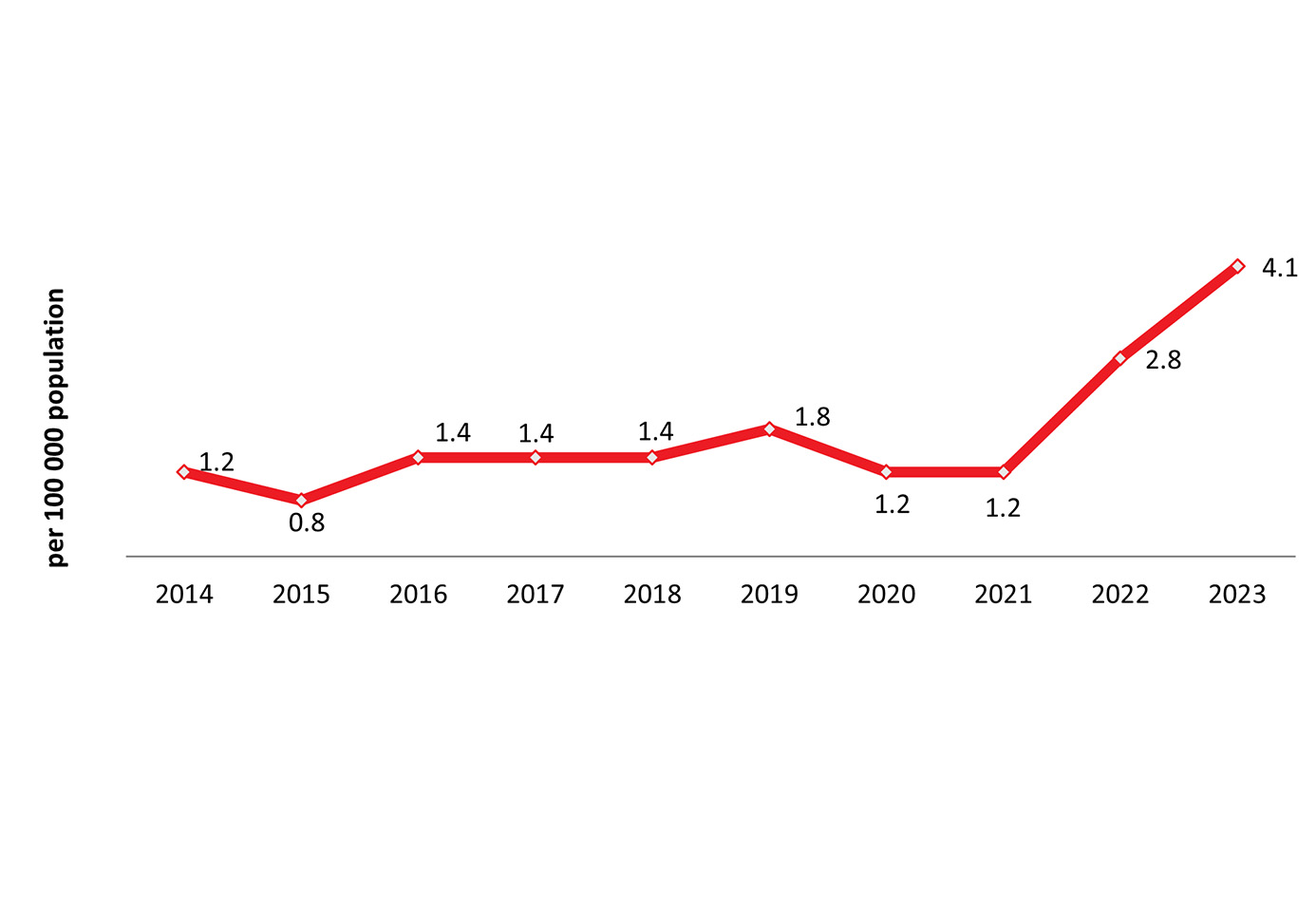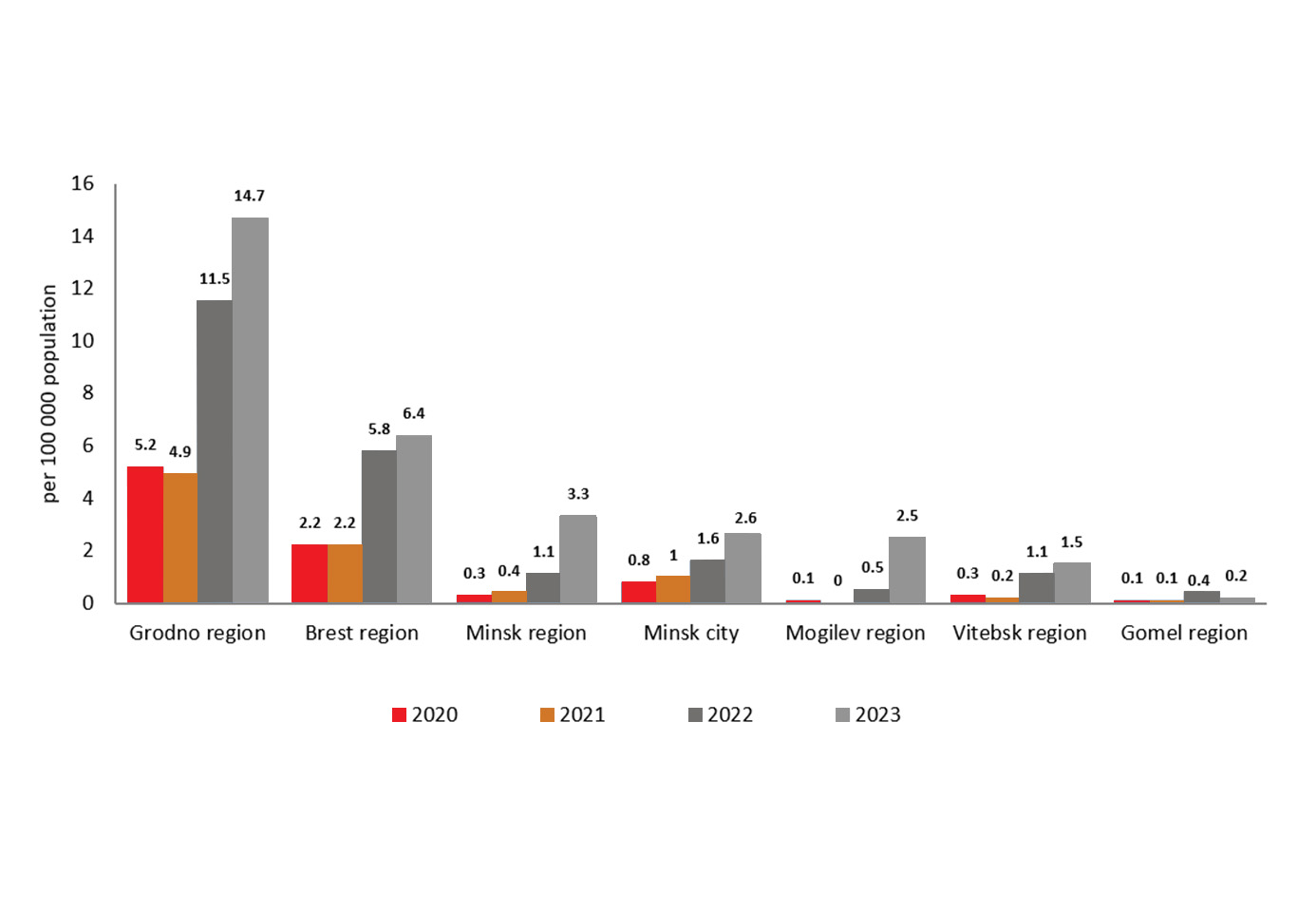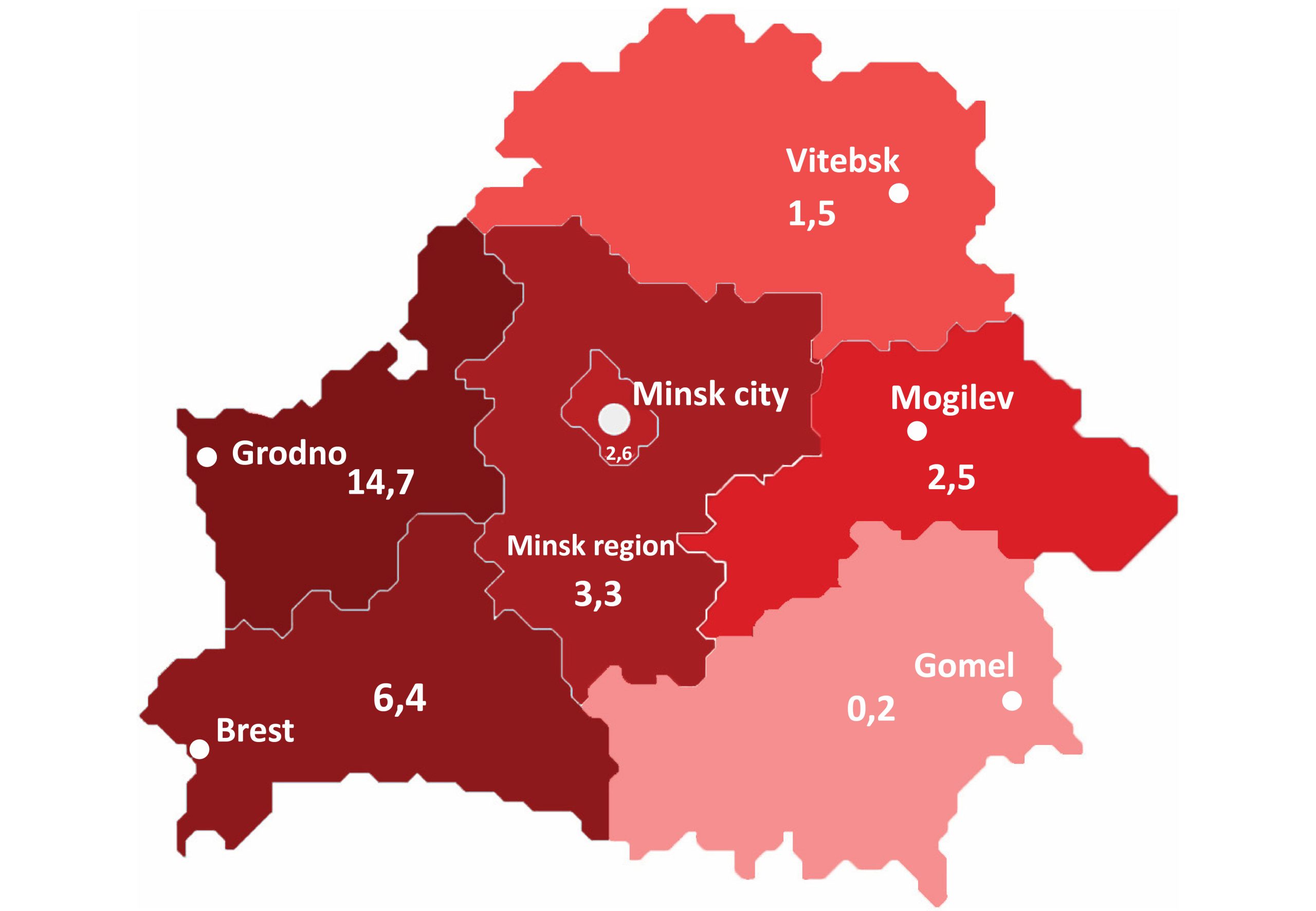Oksana Hanenko, Natalia Kolomiets, Alla Dashkevich, Vlada Zapolskaya, Igor Stoma
E-CDC risk status: endemic
(last edited: date 01.04.2024)
History and current situation
Tick-borne encephalitis is endemic in Belarus. The Tick-Borne Encephalitis Virus (TBEV) was first isolated in the country from Ixodes ricinus ticks in 1939 and from humans in 1954.1,2 According to the multi-year follow-up data (2014-2023), a rise in TBE incidence among the national population has been recorded since 2022 (2.8 cases per 100,000 population) and reached its current peak with 4.1 cases per 100,000 population in 2023 (Figure 1).
From 2020 to 2023, a total of 844 TBE cases were registered in Belarus. During this period, there was a tendency for an incidence increase in all administrative territories of the country, except for the Gomel region. TBE incidence rates in the Grodno and Brest regions were the highest and exceeded the national average in all the years of observation (Figures 2 and 3). The age structure of patients was dominated by people over 18 years old (802 out of 844 [95.0%]). Gender structure was dominated by males (526 out of 844 [62.3%]). In the vast majority of cases transmission mode was by the bite of infected ticks (766 out of 844 [90.8%]), whereas for 33 (3.9%) of patients it was by consumption of infected raw goat milk. For 45 patients (5.3%) the transmission route was not identified. With regard to seasonality, the share of those who fell ill in July and August accounted for 24.5% (207/844) and 22.9% (193/844), respectively.
Overview of TBE in Belarus
| Table 1: TBE in Belarus | |
|---|---|
| Viral subtypes, distribution | Regional circulation of the European (TBEV-Eu) virus subtype has been established; single natural isolates have been identified as the Far Eastern (TBEV-FE) subtype.3,4 |
| Reservoir animals | Epidemiologically significant Ixodidae ticks is presented by two mass species: Ixodes ricinus and Dermacentor reticulatus. Their parasitization has been observed on more than 65 species of vertebrates living in forests, as well as on cattle and domestic animals.2 Some few isolates from natural reservoirs have been characterized as Ixodes persulcatus.2,5 |
| Infected tick species (%) | The detection of TBEV in Ixodes ricinus and Dermacentor reticulatus ticks was 0.27% in 2022 and 0.37% in 2021 out of the total number of specimens examined in those years, 3978 and 3741, respectively.6 |
| Dairy product transmission | Documented for 3.9% of cases |
| Case definition used by authorities | None specified |
| Type of reporting | Mandatory |
| Other TBE-surveillance | No |
| Special clinical features | Out of 844 patients, 79 patients (9.4%) had a severe clinical form of the disease; 3 cases had a fatal outcome (case fatality rate: 0.4%). Fatal cases were registered in highly endemic areas of the country (the Grodno and Brest regions). |
| Licensed vaccines | TBE vaccines registered in Belarus7: TICOVAC, TICOVAC JUNIOR, Tick-E-Vak, Encevir |
| Vaccination recommendations | Risk groups: employees of forest managing organizations working in the territories of: the National Park “Belovezhskaya Pushcha”; the Berezinski Biosphere Reserve; other enzootic areas.8 Vaccination is also recommended for all the people travelling to or living in endemic areas9 |
| Vaccine uptake | Unknown |
| National Reference center for TBE | None |
Figure 1: Yearly notification rate of tick-borne encephalitis cases per 100,000 population, Belarus, 2014–2023

| Year | Number of Cases |
|---|---|
| 2014 | 113 |
| 2015 | 75 |
| 2016 | 133 |
| 2017 | 136 |
| 2018 | 134 |
| 2019 | 168 |
| 2020 | 108 |
| 2021 | 108 |
| 2022 | 260 |
| 2023 | 368 |
Click the image above to enlarge
Figure 2: Yearly notification rate of tick-borne encephalitis cases per 100,000 population in the administrative territories of Belarus, 2020-2023

Click the image above to enlarge
Figure 3: Map of TBE cases per 100,000 population in the administrative territories of Belarus in 2023

Click the image above to enlarge
Contact
Igor Stoma
igor.stoma@gmail.com
Authors
Oksana Hanenko, Natalia Kolomiets, Alla Dashkevich, Vlada Zapolskaya, Igor Stoma
Citations
Hanenko O,Kolomiets N, Dashkevich A, Zapolskaya V, Stoma I. TBE in Belarus. Chapter 13. In: Dobler G, Erber W, Bröker M, Chitimia-Dobler L, Schmitt HJ, eds. The TBE Book. 7th ed. Singapore: Global Health Press; 2024. doi:10.33442/26613980_13-2-7
References
- Votyakov VI, Protas II, Zhdanov VM. Western tick-borne encephalitis. 1978.
- Bychkova EI, Fedorova IA, Yakovich MM. [Ixodid ticks (Ixodidae) in Belarus]. 2015.
- Samoilova TI, Votyakov VI, Mikhailova AA, et al. [Genotyping of tick-borne encephalitis viruses isolated in Belarus using nucleotide sequence sequencing]. 2007. Accessed April 9, 2024. https://med.by/dmn/book.php?book=07-7_3.
- Zlobin VI, Verkhozina MM, Demina TV, et al. [Molecular epidemiology of tick-borne encephalitis]. Vopr Virusol. 2007;52(6):4-13.
- Bespyatova LA, Bychkova EI, Yakovich МM, Bugmyrin SV. [Manifestation peculiarities of natural focuses of tickborne infections on the territory of Karelia and Belarus]. Natural resources. 2018;(1):86-91.
- Ministry of Health of Belarus. On the sanitary and epidemiological situation in Belarus in 2022: report.
- State register of medicines of the Republic of Belarus. Accessed April 9, 2024. https://www.rceth.by/Refbank/reestr_lekarstvennih_sredstv/results.
- Ministry of Health of Belarus. [On preventative vaccinations]. 2018. Accessed April 9, 2024. https://minzdrav.gov.by/ru/dlya-belorusskikh-grazhdan/vaktsinatsiya/natsionalnyy-kalendar-privivok.php
- Ministry of Health of Belarus. [On approval of the Instructions on the tactics of carrying out preventive vaccinations among the population in the Republic of Belarus]. 2014. Accessed April 9, 2024. https://minzdrav.gov.by/ru/dlya-spetsialistov/normativno-pravovaya-baza/baza-npa.php?ELEMENT_ID=331869